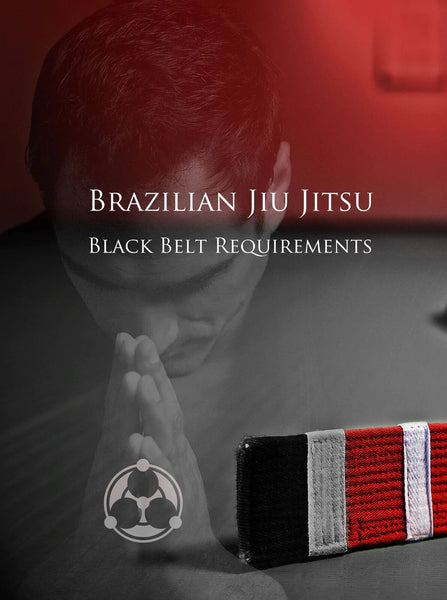How Long Does It Take To Earn a BJJ Black Belt?
Posted by Benjamin Strusnik on
Brazilian Jiu Jitsu Background
Brazilian Jiu Jitsu is a relatively young martial art. As the story goes, the seeds of judo and Japanese Ju Jitsu were sown during visits by high level Japanese martial artists in Brazil in the first half of the twentieth century. Most notably, the Gracie family lead by brothers Carlos and Helio took the lessons of their Japanese visitors and modified the techniques starting what we know today as Brazilian Jiu Jitsu.
For more on progression to the BJJ black belt, check out Roy Dean's instructional on the topic!
In the late seventies, members of the Gracie family began emigrating to the United States to explore opportunities to share the family's martial art. One of the earliest American pop culture references to Brazilian Jiu Jitsu came in the highly popular Lethal Weapon movie series, where in the first installment, star Mel Gibson made use of a triangle choke during a fight scene at the end of the film. It turns out Rorion Gracie had helped choreograph some of the fight scenes.
In the early 1990's Rorion Gracie and business partners decided to create the Ultimate Fighting Championship, an event that was designed to answer the age old question of which martial art was most powerful. In this event, experts from martial arts around the globe would enter and attempt to defeat opponents. Rorion's brother Royce, a relatively small member of the family would go on to win the first installment of the Ultimate Fighting Championship and light a fire that continues to grow to this day.
The BJJ Practitioner and Journey to Black Belt
When a practitioner first steps on the mat, it is as a white belt. With dedication and diligence to the practice of the martial arts, the student will move through a progression of four initial belts, the white, blue, purple, and brown before being considered for the coveted black belt. The road through the BJJ Belts can be circuitous to say the least. The BJJ Belt Meanings also can vary slightly from school to school and instructor to instructor.
The time it takes to make this progression varies and depends on a number of factors. In simplest terms, one can expect to spend upwards of 1-2 years and maybe more at each of the belt levels. Specific time frames and requirements vary amongst instructors and academies, but it's safe to say that the average practitioner with consistent attendance three or more days a week, is look at a decade of practice before they are considered for black belt.
There are a number of factors that the instructors look at to gauge someone's progression. Let's take a look at them and how they can impact your overall growth as a BJJ student.
Your BJJ Skill
In this day and age of 72 hour cleanses and 30 day or six week fitness makeovers, the thoughts of dedicating oneself to an activity for the next decade can seem daunting and it should. Unlike other martial arts where a student can feasibly achieve a black belt in 3-5 years or less, development in Brazilian Jiu Jitsu is much more grounded in practical application.
Striking martial arts like Tae Kwon Do or Karate require a great deal of theatrical practice due to the danger of actually utilizing the techniques with 100% force. One can't just perform a full-force round house kick on one of their instructors to allow the instructor to gauge their skill and improvement over time. It's simply too dangerous. For this reason, the striking martial arts in the United States especially have adopted activities like breaking boards and performing kata to gauge skill.
Brazilian Jiu Jitsu on the other hand is extremely unique in that it can be practiced at 100% safely and effectively. Once a submission has been applied, the opponent will be forced to "tap out" signaling that they have been caught and training can continue. No one is hurt and everyone is able to enjoy the full practical application of the art, thereby making it one of the most effective martial arts to learn for self defense.
This gives your instructor a great deal of information about how you are progression. They will be able to assess your ability to move through different positions and gauge your attempts to secure submissions. There's no hiding one's skill in jiu jitsu. When put in a bad position, the skilled practitioner is able to easily escape to a position which is more advantageous to them, while the unskilled practitioner will remain stuck and many times tap to the pressure.
Even at black belt your techniques does not have to be perfect, but after years of moving through positions, one should be able to make use of their technique to move intelligently on the mats. Assessing your overall skill will go a long way in how soon an instructor will feel you've achieved the necessary level of skill of a black belt. Some students also enjoy competing in BJJ competitions. Though you are not required to compete to achieve the black belt, competitions can be a good way for your instructor to measure your development.
Your BJJ Training Consistency
When one first starts jiu jitsu, it can seem like everyone knows a bunch of secrets that you have no idea how to figure out. Heck, you don't even really know if you know how to tie the jiu jitsu belt. But in reality, there really are no secrets. If there was one secret to getting better at jiu jitsu, it's with mat time and consistent training.
What does consistent training look like? Is it three days a week? Is it more, or is it less? First off, it depends on your lifestyle and goals. If you're an over 30 professional, with a career and family, your frequency of training could be different than the 18 year old high school graduate living with their parents. Also, in terms of goals, if you are looking to be a competitor, your training frequency will be much different than an over 40 professional with a family.
In simplest terms, it's important to set up a schedule and stick with it the best you can. If you're a hobbyist, 2-3 sessions per week is the minimum you should be striving to attend to be able to progress and still be on pace for the black belt in a decade. Although overall mat time is one of the most important aspects or factors impacting your progression, it's important not to train 5-7 times in one week and perhaps once or not at all the next week. This is not conducive to longevity as a practitioner.
Training consistency will have the biggest impact on your overall skill development. Time on the mats is spent practicing the techniques taught in class or gleaned from other sources like instructional videos. Consistently training also helps solidify you as a dedicated resource at your academy and as you progress, you may find yourself taking on more responsibility as a coach or instructor as time goes on.
Your BJJ Leadership
As you progress from white to blue belt and then to purple and brown belts, you will naturally find yourself in a position to help or mentor newer students. Helping others can be a key factor in how to become a black belt in BJJ. You may even be granted the opportunity to coach or instruct a class. As your skill begins to increase, you will begin to see opportunities to share what you've learned and develop a position as a leader in your academy. This is when you're truly on the path to black belt, when during the journey, the development of peers and fellow students becomes just as important as your own.
As a leader at your school, it's important to ask yourself what you can do to be the best role model for the art. Gaining rank in jiu jitsu can oftentimes carry a sense of responsibility as the new white belts look to you for guidance and mentorship.
Becoming an instructor can be one of the most rewarding experiences of your Brazilian Jiu Jitsu journey. The martial art itself is very complex. It takes time and effort to begin to master the complicated techniques. To be able to take something complex like BJJ and teach it to an inexperienced student, can sometimes take more skill than it took to master the technique for oneself.
But in the process of learning to teach, it's important to understand that because you are a brown belt in the art with great skill, you are most likely a white belt at teaching and there are some skills you will need to learn and sharpen to make yourself a brown belt instructor and eventually beyond.
One of the simplest ways to begin developing those skills is to make sure that everyone in your class feels successful about one thing during the class. It doesn't have to be their ability to put the move into practice. It can be something much smaller. Or perhaps they were being an excellent partner with another student, and you make sure that you point that out.
At the end of the day, as a new student, the most important thing to do on the way to black belt is to make peace with the fact that it's a long and somewhat challenging journey that's not always going to be fun. Many times, you will leave the academy wondering if this martial art thing is for you--but you must not stop. The key to success, the key to the black belt is never quitting. In ten years, a lot of things can change.
One can finish college multiple times in that length of time. One may change careers and relocate or move to start a family. By consistently sticking with BJJ despite all of the changes life can throw at you, you will prove that your dedication and with that time and training invested, you will improve and your instructor will eventually award you the coveted black belt.
So as a new white belt, concentrate on focusing on the white belt goals that will help you survive and build the foundation.
Ironically, many who receive their black belt comment that once they achieved the black belt, it was like they had finally gotten started in the art. And isn't that the fun of life, to constantly be learning new things?
For more about how to achieve the BJJ black belt, check out Tom DeBlass' Road to Black Belt and Beyond!
- How To Wash BJJ Belt
- How Long to Get Brown Belt In BJJ?
- You Are a Purple Belt: But What Does That Mean?
- What Is a Brown Belt in Jiu Jitsu?
- How Long Does It Take to Get a Blue Belt in BJJ
- Blue Belt BJJ Requirements
- How Long Does It Take to Get a Purple Belt In BJJ?
- White to Blue Belt BJJ
- Jiu Jitsu White Belt Moves
- Blue to Purple Belt BJJ
- BJJ White Belt Tips
- BJJ Black Belt White Bar
- Black Belt BJJ
- How Many BJJ Black Belts Are There
- Youngest BJJ Black Belt
ARE YOU A BJJ FANATICS INSIDER? IF NOT, YOU’RE MISSING OUT!
Take a deep dive on one specific skill per month with the top instructors in the BJJ Fanatics family.
With your subscription you’ll get:
- Private Lesson (Masterclass)
- Preview of our Upcoming Daily Deals to better plan your purchases
- Rolling breakdowns & more.
You’ll also get At Home Drills to work on, a Preview of our Upcoming Launches More!
FREE FOR 7 DAYS TRIAL



